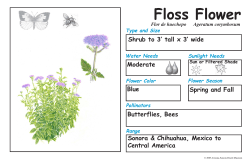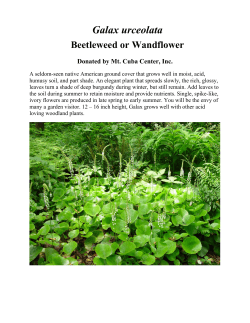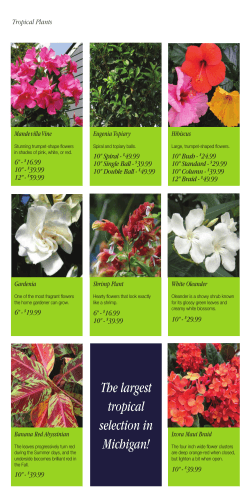
Protecting Your Waterfront â Part 2 of 2: Plants for the Waterfront
Protecting Your Waterfront – Part 2 of 2: Plants for the Waterfront By Joe Wolf Polk County Master Gardener The characteristics of a waterfront are important when deciding what plants to use in that unique landscape. Those characteristics are: how much the water level fluctuates with the season and with a hurricane; the structure of the soil both on the bank and under the water near the shore; the slope of both the bank and underwater; light available; erosion control; and the use of the waterfront. These characteristics were described in the first of this two part series. Florida regulations require plants used in the water to be native plants. Plants above the water level do not need to be natives, but native plants do well in that environment and usually require little maintenance. Blue Flag Iris As with all landscapes, choosing plants that are aesthetically pleasing to you and meet your goals for the waterfront is critical. The following is a list of some plants that are suitable for the retention pond or lakefront but only if used in the proper place. The list will describe those areas for each plant. Plants to place on the bank down to the water: Fakahatchee grass (Tripsacum dactyloides) is a clumping grass with dark green foliage. The standard variety grows four to six feet tall. A dwarf variety will only grow two to three feet in height. Both like full sun or partial shade. It is deciduous and old leaves should be removed in February or March within a few inches of the soil. Muhly grass (Muhlenbergia capillaris) is one of the most decorative of Florida’s native clumping grasses. One of the most beautiful features of this grass is the pink wavy blooms in the fall. The entire clump seems to turn pink. It will stay green all year with long narrow leaves. It can grow from three feet to five feet tall and spread two or three feet. Another important characteristic is that it can grow in almost any soil either moist or dry. It can be used by the lake, on the bank to hold the soil or anywhere else in the landscape. It grows best in full sun. Blue mistflower (Conoclinium coelestinum) has a Muhly Grass pretty, pale blue flower that appears from July to November. Mistflower spreads both vegetatively and by seed in full sun or partial shade in moist soil where it will grow to a height of two to three feet. Monarch butterflies love it. African iris (Dietes iridioides) is a clumping flower that can bloom any time of year but specifically in the spring and summer. Flowers are about three inches in diameter growing on the top of a tall flower spike and are white Rose mallow sometimes with yellow or blue highlights. The leaves are thin and sword-like about two feet long and radiate up and out in a fan shape. The African iris will grow in either full sun or partial shade and in wet or dry soil. In dry soil, it will grow two to three feet tall but near water four to five feet tall. Blue porterweed (Stachytarpheta jamaicensis) is another plant that can be used anywhere in the landscape, by the water in moist soil or up in the dry sandy areas. Butterflies and bees love its tiny blue flowers that grow on tall, stringy spikes. It will grow to about two feet tall, and will spread three feet in full sun. Leaves stay dark green all year. Passion vine (Passiflora incarnate) is a vine with dark green leaves and a beautiful, distinctive, lacy, purple Passion Flower flower. It is a perennial and flowers from April to August. It grows best in moist soil in the full sun. It will only be about six inches above the ground except where it climbs up a support. There are seven species of passion vine native to the Florida. Passiflora incarnate grows well in moist soil but others will do well in dry areas of the landscape. Hibiscus or Rosemallow: (Hibiscus spp.) is a group of ten shrub species also called Hardy Hibiscus. They grow in moist soil down by the water or higher on the bank where it is dry. It grows up to about twelve feet tall and four feet to ten feet in diameter. In cold weather, they can die back to the ground but then will regrow in the spring. The flowers are numerous and very large, up to five inches in diameter. Flowers are red, white, pink, yellow and anything in between. Multicolor varieties are available. Plants that do well in or very near the water: Golden Canna Golden canna (Canna flaccida) has a beautiful, showy, three-inch long yellow flower. It will grow well either in the water (up to about eighteen inches of water) or at the edge. It is usually found in small stands and will reach four feet in height. The leaves are oblong to elliptic with a tapered base and pointed tip and from six inches to two feet wide. They grow in a spiral down the plant’s stalk. It wants full sun to part shade. Lanceleaf Arrowhead Swamp lily (Crinum americanum) is another lily with a beautiful flower. Flowers have six white to pink fragment petals. From two to six flowers grow at the top of the plant’s stalk. This lily performs best in partial shade and in the water near the bank to about three inches of water. The leaves are upright and straplike about two feet long and three inches wide. It will grow in clumps from bulbs in the bottom of the lake. There are similar looking crinum lilies that grow on land. Sand cordgrass (Spartina bakeri) is a robust, clumping ornamental grass that can grow up to twenty feet in diameter in the water or on land near the water’s edge. It will grow up to four feet tall with fine textured, wiry leaves that form a fountain spray pattern. These leaves are dark green on the top and a lighter green on the bottom. It does best in full sun. Flowers are small, white and inconspicuous. Lanceleaf Arrowhead (Sagittaria lancifolia) is one species among a couple of similar plants called Duck potato (Sagittaria graminea, Sagittaria latifolia, Sagittaria lancifolia). These plants are upright clumping flowering perennials that will grow from one foot to five feet tall in the water. They are hefty plant with leaves in the shape of an arrowhead growing on sturdy stalks. The flowers are white with a yellow central disk that flowers all year long. It grows in up to six inches of water and in full sun or partial shade. Pickerelweed (Pontederia cordata) is one of the best erosion control plants. It has tall purple flowers that bloom all year long. It generally grows 2 to 3 feet tall with leaves that can be 5 inches across. Grown with various duck weed species and common spikerush it provides diverse textures and colors and great wildlife habitat. It should be planted in large patches. The above plants, except the African Iris, are all native to Florida. Using them and others in the references below will make your landscape more beautiful; bring in birds, bees, butterflies and other animals. Most importantly, it will protect your waterfront. For further information, please see the publications: https://edis.ifas.ufl.edu/pdffiles/EP/EP47600.pdf and http://edis.ifas.ufl.edu/pdffiles/FA/FA00700.pdf and http://myfwc.com/media/2518526/LakefrontRevegetation.pdf .
© Copyright 2025









